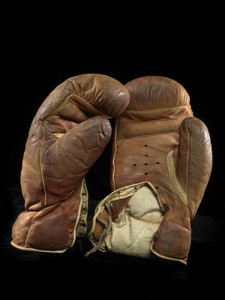Smithsonian Gets Their Mitts on Gene Tunney’s Gloves
/https://tf-cmsv2-smithsonianmag-media.s3.amazonaws.com/filer/20110520110720Tunney2.jpg)
Resembling a Roaring '20s version of Jean-Claude Van Damme, Gene Tunney (1897-1978) was the World Heavyweight Boxing champion from 1926 to 1928. He was best-known for snatching the title in 1926 from the punching powerhouse that was "Manassa Mauler" Jack Dempsey, and then defending it successfully against him again in 1927 in the infamous “Long Count Fight.”
This week, the Smithsonian's National Museum of American History officially acquired the gloves from that historic fight, along with several other items from Tunney's career, from his family.
A thinking boxer who could bring the wood when necessary, Tunney was quick to make adjustments and tough in the ring. Tunney was never KO'd during his career, and was only knocked down once, finishing his career with a record of 61-1-1, with 45 wins by KO.
Though Tunney was the reigning champ at the time, Dempsey was favored in the rematch that took place at Chicago's Soldier Field on September 22, 1927. This time, the pugilists fought under new rules regarding knockdowns–the fallen fighter would have ten seconds to rise under his own power after the opponent moved to a neutral corner (one with no trainers). These rules were not yet universal, but they were requested by the Dempsey camp.
Tunney was leading in points after six rounds, fighting from a distance against the Mauler. But things got interesting in round seven, when Dempsey got Tunney against the ropes, and with a flurry of punches, knocked him down for the first time in Tunney’s career.
Dempsey didn’t immediately abide by the new rules regarding knockdowns and go to a neutral corner, instead reverting to his usual behavior of standing over his fallen competitor. The referee, Dave Barry, ordered Dempsey to a neutral corner, but Dempsey took several valuable seconds to respond. By the time Dempsey reached a neutral corner, Tunney had been down for approximately 4 to 6 seconds. Barry couldn’t begin counting until Dempsey reached the neutral corner, but he still reached a count of nine on Tunney before Tunney got up. Many believe that Dempsey would have scored a knockout had he immediately returned to a neutral corner after falling Tunney.
In films of the fight, superimposed clocks record Tunney’s total down time as approximately 13-15 seconds, and the delay in the start of Barry’s count gave the match its nickname. Tunney regained his wits and control of the fight by the eighth round and went on to win the match by unanimous decision.
"He always said he could have gotten up sooner," Tunney's son Jay told Tim Dahlberg of the Associated Press. "He said it from the moment I can remember, and I'm sure he could have."
/https://tf-cmsv2-smithsonianmag-media.s3.amazonaws.com/accounts/headshot/Jeff-Campagna-240.jpg)

/https://tf-cmsv2-smithsonianmag-media.s3.amazonaws.com/accounts/headshot/Jeff-Campagna-240.jpg)